While my saddle is being adjusted for Tonka’s more athletic physique, I have been riding bareback (with a pad, which, honestly, doesn’t do much!) Riding bareback has kept Tonka and I at a walk. There’s a lot that can be accomplished at this gait. Dressage is all about fine-tuning communication and developing athleticism with an eye towards flow and balance. For the last two weeks, Tonka and I have focused on some simple, but transforming, work.
For starters, it’s always good to get a forward walk at the beginning of a training session. This doesn’t simply happen. Here I’m asking Tonka to move on. (I ask with body language. It’s a matter of how I sit, a squeeze of my legs, even where my elbows are.) Notice that Tonka’s tail is swinging in a relaxed way. He’s also got his ears forward and a soft look on his face. Those ears will change as I ask for more physical and mental exertion. As I increase the criteria, his ears will come back as he focuses on me. Back is okay. Pinned flat, which is an indication of anger or frustration, are not. I keep an eye on his attitude.
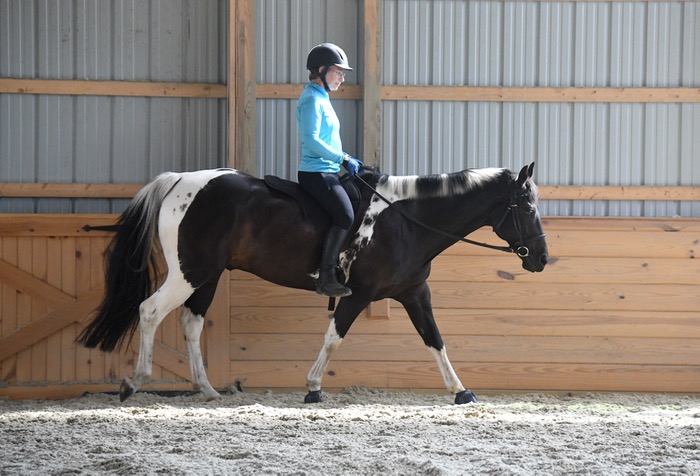
The above photo is pleasant, but notice that he’s carrying most of his weight on his forehand. Moreover, when I ask Tonka to increase his stride in length, his inclination is to pull forward with his front legs, not power from behind. This hollows his back and puts even more stress on his forehand. If Tonka continues to go like this, he’s prone to injury.
The next photo is ugly. Honestly, it makes me cringe to share it, but it’s important to see – to show what we are trying to improve on.
Have you ever worked out with a personal trainer? Who insists that you use a weak muscle group, and how it takes a bit to find those muscles and get them firing? Here I’ve asked Tonka to step under himself. He says that instead, he can go the speed that I’m asking for by hollowing his back. He’d rather not use those weaker muscles. His ears are pinned back.

After a few strides of this, Tonka goes into an attractive frame. I thought that eventually those few ugly strides would cease to happen. They haven’t, and this walk work made me realize that I have to fix that moment of transition.
So I asked in a way that allowed him to get into gear without having to so dramatically evade the work. I reinforced these moments of transition (sometimes with cookies, or praise, or a relaxed walk break.) Now we were getting willing transitions, done in a consistent, correct frame, that flowed into a balanced walk. We were both happier. Notice the ears.

Here’s another ugly picture. Tonka is what is termed behind the bit. His nose is tucked behind the vertical. In this way, he can avoid both the feel of the bit and let his hind legs lag. He’s telling me that my hands are giving him mixed messages, and that he’s still not in balance.
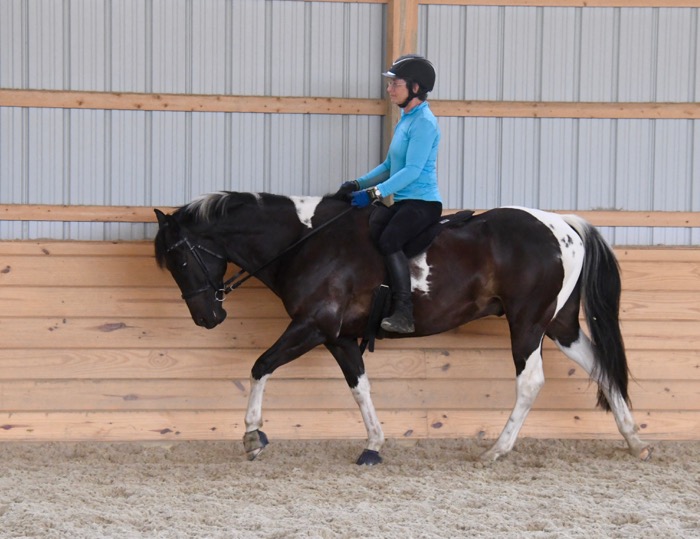
So we do transitions from working walk to stretch walk and back again.

Another way to get Tonka to engage his hind end is to walk over poles on the ground. The outside ring has some set up, and we’ve been going through those daily. At first Tonka hit the poles with his toes. Now he doesn’t.
Just like humans are right or left-handed, so are horses more capable on one side over another. Tonka is stiffer to the right. So, we’ve been doing circles and serpentines at the stretch, working, and medium walks (each have a different engagement and head set.) The goal is that instead of bracing against my body to the right, he softens and bends. His ears show concentration but not frustration. Notice how Tonka’s hock is articulated, he’s stepping under himself, and his poll is the highest point of the neck.

A dressage horse needs to move off the leg. Depending on how I apply my leg, either he goes forward, or sideways. At First Level (which we are showing at this year) there are leg yields. We go to the left.
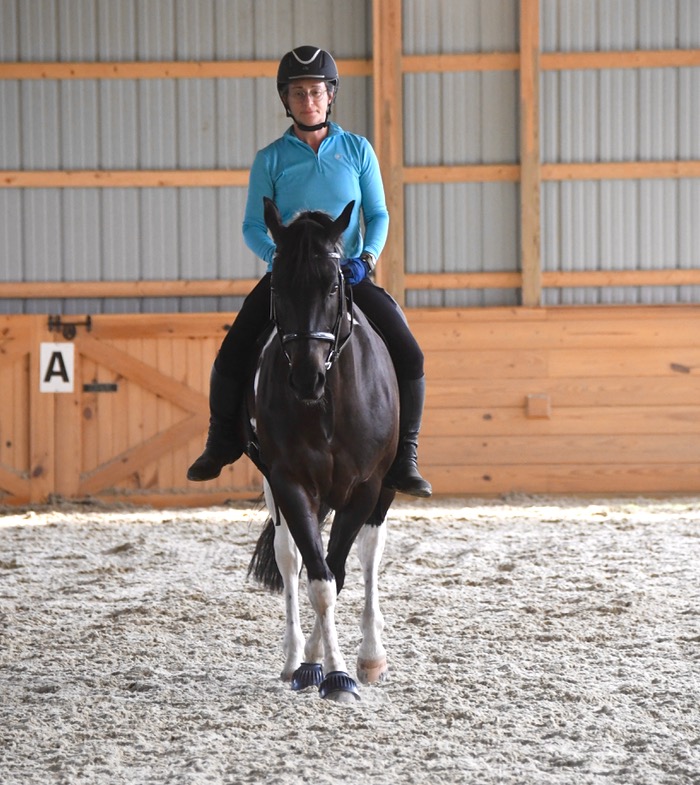
We go to the right.
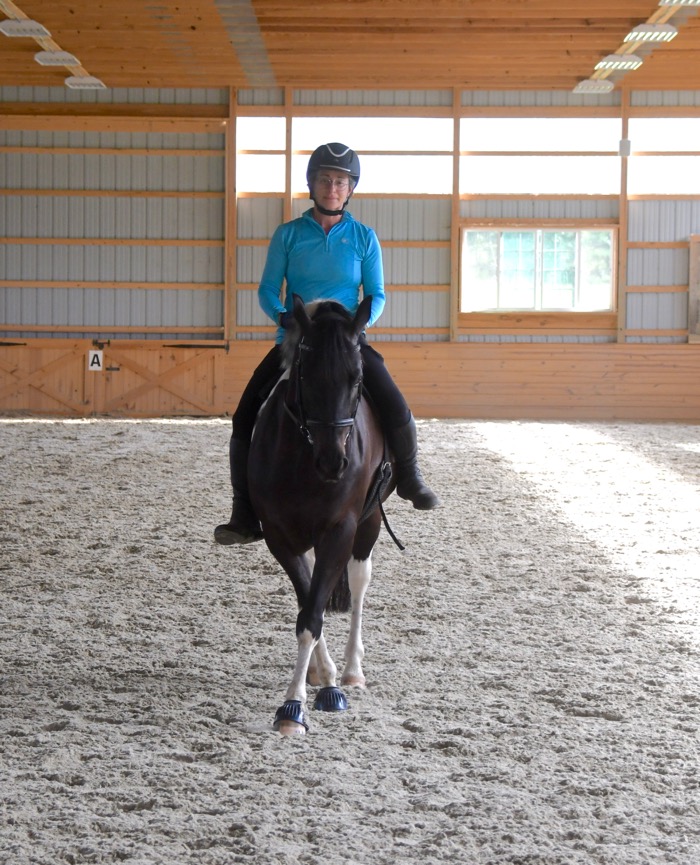
Along with getting him responsive to my leg, these exercises get Tonka to engage those hocks and free his shoulder.
Transitions are also a great exercise to get the horse to listen and respond quickly. We’ve been doing walk-halt-walk, and we’ve been making sure that those halts are square. (Almost!)
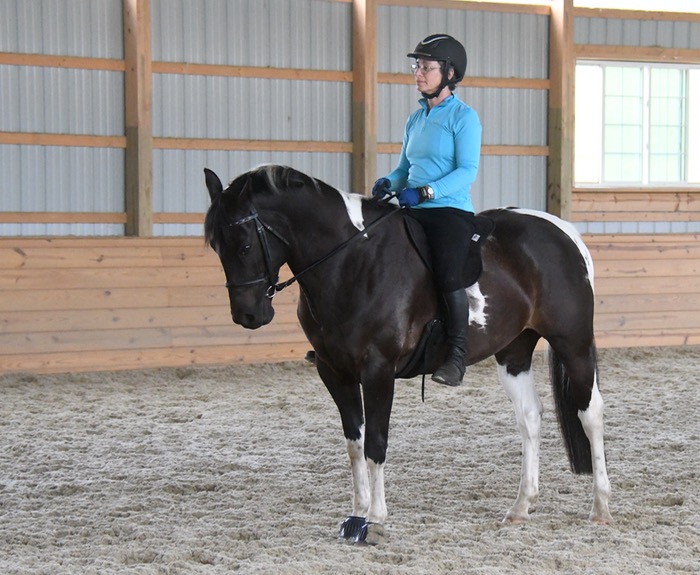
When we are in sync I tell him he’s right with a verbal marker (I say Dee!) and we halt and I give him a cookie. Tonka also finds verbal praise, wither scratches, and breaks in the work, reinforcing. I’m always looking for that good stride, and he is too.
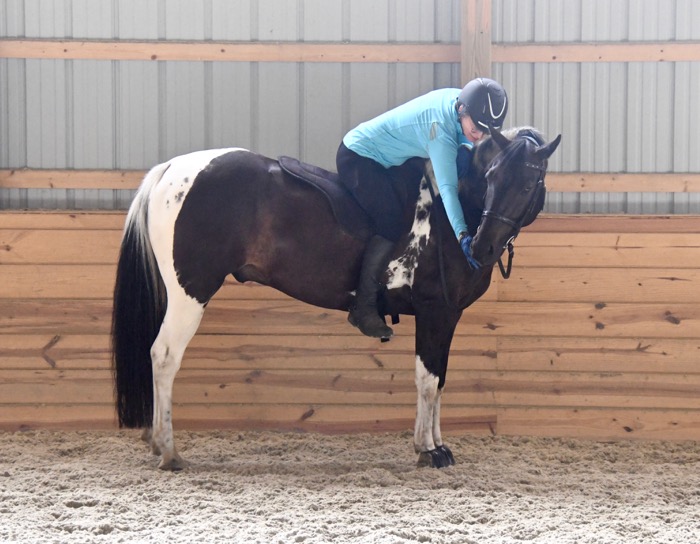
I’m picking up my saddle today. I think that all of this work at the walk is going to translate to the trot and canter. I’ll let you know!


I think that Tonka is very, very, very smart. You’re pretty good too Terry. Seriously, I know nothing about horses and riding, but your blogs are fascinating!
Thank you! I’m glad that you’re able to enjoy my horse. It’s fun sharing him. (And he thanks you for the peppermints!)
I’ve been working with my horse over the last year to teach him (and I!) how to move off his hind end. I’ve been bringing him back from an injury to a front pastern, which caused problems with his rear stifles, and led to almost a year off. No one had ever taught him to engage his back muscles and move off his hind end, and he was constantly moving like the “ugly” pictures you posted, all strung out. Unfortunately, I think lots of trainers don’t ever think to teach their horses how to move correctly; they think that because a horse doesn’t buck off a rider, they are a finished horse! And most owners don’t know that teaching their horse to work in a frame will help to prevent some (not all of course) injuries over their horses’ lifetimes. It’s definitely become a pet peeve of mine, watching how most horses move like potatoes! I’ve definitely had to learn a lot, but it has been beneficial to both of us, and helped to keep him sound. Now he has muscles I’ve never seen before! My potato is definitely becoming a handsome prince, much like Tonka!!!
Thanks for sharing your story. A horse with stifle problem really needs to stay fit and move correctly in order to move comfortably at all. Good for you to take the time and effort to do it right. Here’s to all of our handsome princes!
A lovely instructional post!
I appreciate your comment. I’ve had your horse, Lance, on my mind. What a hard road you’ve had, but you’ve gone down it with thought and patience. Sending healing wishes your way.
Fun! Glad the bareback work is going well! One of the best parts IMO is how you can be so precise with your leg cues. You can actually cue with your thigh and butt muscles without having to shift your seat. I think every dressage rider should spend some time working bareback at the walk. So much nuance!
If you manage a bit of trot, imagine adjusting the tension of your thigh muscles like long rubber bands to absorb the horse’s movement.
The long rubber band visual is a good one. If only my thighs were still as elastic as they were a few decades ago 🙂
Very informative and interesting blog. Tonka has changed so much since you have more time to spend on dressage training. Jess and I love reading the blogs and follow with interest all that goes on. Your relationship with Tonka seems to be even stronger than before, you seem to think as one and that is all down to your hard work. We wish you all the best for future competitions…:)
Great to see right and wrong horse body frames. Most dressage people wouldn’t show us, but this helps us to learn thankyou. Lynn C.
It isn’t easy to post the ugly ones! I’m just relieved that I had more good photos than bad and could show those, too 🙂